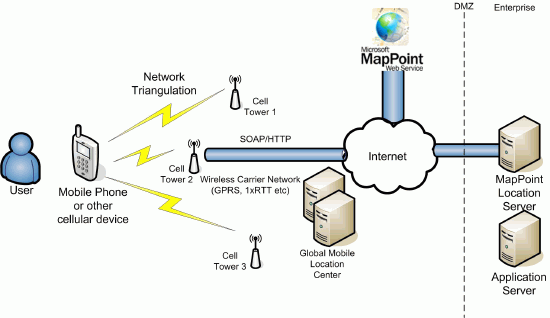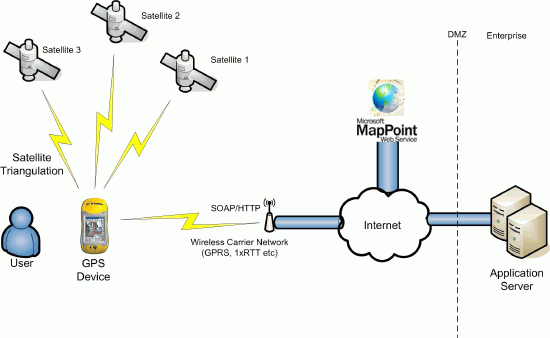MapPoint Location Server (MLS) is designed to allow access to a user's location information from a mobile carrier network or other provider such as a WiFi network.As mobile network technology has evolved and regulations mandate mobile carriers to have the ability to locate mobile phones, carriers have adopted location determining equipment in their networks.These technologies include Cell Site ID, Triangulation or Assisted GPS (A-GPS).The specifics of these technologies and accuracy vary, but the key thing is most mobile operators have or are developing technologies to determine the position (latitude and longitude) for a user (as long as the user has permitted tracking to ensure privacy).The typical accuracy of these network based location services range from 10 feet to a mile, and can take a few seconds up to half a minute to acquire user's location depending on the location algorithms and network latency.But for many LBS scenarios this combination of decent accuracy and low cost devices is very compelling.The biggest challenge with mobile operator and other sources of position information is that each operator has a different API and security to access this information (e.g.Openwave Location Studio), so incorporating location information from users on different networks is very challenging.MLS is designed to address this challenge by providing industry standard Web Service APIs for accessing location information from multiple mobile operators; each carrier is and will be supported in a MLS Provider abstracting the complexity away from the enterprise developer. MLS will also have providers for other types of location determining scenarios such as locating a user that is active on a WiFi network or hotspot making it a very flexible platform for LBS.Additionally, MLS has advanced features for security, privacy and application development.Diagram 1 shows a typical MLS architecture for LBS scenarios.

Diagram 1 - LBS Architecture using MapPoint
Location Server with a wireless carrier provider
Most people have heard of Global Positioning System (GPS).GPS is a technology that has been available for many years and typically involves a GPS receiver that is able self-locate based on its relative location to multiple satellites orbiting the earth.Accuracy is typically higher with GPS receivers and with error correction (calculations for delays due to the atmosphere) GPS can provide accuracies to just a couple of feet (and in some specialized devices less than one foot accuracy).GPS receivers are most often built into other types of devices, or peripherals to existing devices but integrated devices are becoming more popular today for example the Trimble GeoExplorer GPS/Pocket PC device.These integrated devices provide a good combination of location accuracy with Pocket PC features, wireless connectivity and ruggedized device reliability.Because of the nature of GPS technology with location being determined on the device and not a network based acquisition of position information, enterprise scenarios typically involve the use of additional wireless connectivity to transmit location information to a central server.

Diagram 2 - LBS Architecture using GPS devices
So you want to create a LBS solution, and what location determining technology is best? That depends on devices that you may already own, your budget, desired accuracy and type of LBS solution. MLS/network based LBS scenarios are very well suited to scenarios where traditionally GPS has been too expensive; these include field force scenarios for small and medium sized organizations, intelligent dispatch, and many other enterprise personal productivity scenarios such as finding team member, proximity searches, driving directions etc.MLS also provides access to location information in enterprise scenarios where typically GPS would have rarely been used (e.g. presence information in IM).Traditional GPS devices are most useful where high accuracy location information is required and where wireless connectivity cannot be assured such as field survey scenarios, turn by turn directions, accurate mileage calculations etc.To help explore the right technology for your scenarios, Table 1 shows a comparison of the key criteria for evaluating MLS and GPS technologies.
Table 1 - MLS/GPS Feature Comparisons
|
Comparison Criteria |
MLS |
Traditional GPS |
|
Accuracy |
10 feet (A-GPS) up to a mile (Cell Site ID) |
< 3-10 feet and up (specialized devices can give sub foot) |
|
APIs |
SOAP web services |
Device drivers and utilities |
|
Device options |
Any mobile phone based device (cell phone, Pocket PC, smart phone) or other wireless device (WiFi card) |
GPS enabled device (stand alone, integrated Pocket PC, GPS peripherals) |
|
Device cost |
Lower ($0-$500) |
Higher $200-$5000 |
|
Lat/Long Request Cost |
Per request or flat rate (i.e.$20/month per user) for wireless carrier, other MLS providers vary. |
No fee after initial device cost |
|
Reach |
Only within provider coverage areas (wireless carrier or WiFi etc) |
Worldwide |
|
Indoor |
Yes, however higher accuracy (A-GPS) requires clear sight of sky |
No, clear sight of sky required |
|
Acquisition Time |
Average (depends on accuracy requirements, 1-2 seconds up to 30 seconds) |
Very quick (depends on specific GPS hardware and device APIs) |
|
Wireless Connectivity |
Native with wireless carrier and WiFi enabled mobile devices |
Additional service and cost on mobile/GPS devices |
|
Application scenarios |
Intelligent dispatch, driver routing, personal productivity, presence information in IM |
Traditional GIS, surveying, turn-by-turn directions, remote applications |
As we have discussed, the automatic acquisition of location information either via MLS or traditional GPS devices is essential to LBS scenarios.It is important that you consider the type of solutions, cost and accuracy to determine the best approach.However, specific user position information has low value unless there is a compelling application.The MapPoint Web Service enables developers to create very powerful LBS solutions providing rich maps, driving directions, proximity searches etc.For questions or comments please email steve@milroy.com
More Information
MapPoint Location Server (MLS) - http://www.microsoft.com/mappoint/mls/default.mspx
Trimble Integrated GPS/Pocket PC Devices - http://www.trimble.com/geoxt.html
MapPoint Web Service - http://www.microsoft.com/mappoint/webservice/default.mspx